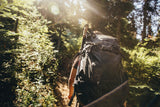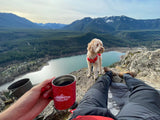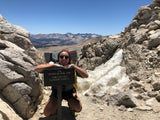Desert Camping 101: How to Survive while Camping in the Desert

Camping in the desert is a wholly unique experience for outdoor adventurers – the other-worldly landscapes, the wildlife, the stars (the stars are mind-boggling on a clear night!). The desert also provides a unique set of risks for hikers and campers. From temperature shifts, to water access, to flash floods, it’s a dynamic environment and knowing the basics of desert hiking and camping is essential for anyone exploring the sandy, prickly wilderness.
This list is not comprehensive but will help keep you safe and having a good time on your desert adventures, from day hikes to car camps to week-long overnighters.
1. It’s Not Always Hot
Deserts aren’t always the searing badlands we picture them to be. Come nightfall, the temperatures can go from scorching to chilling, sometimes dropping below freezing. When hiking and camping in the desert, it is thus in everyone’s best interest to pack according to the expected temperature swings. This means packing sunscreen but also making room for thermal layers, thick socks and a beanie. Make sure your sleeping bag’s temperature rating is low enough to keep you warm at night, too.
(photo: @noaa)
2. Water is Life, Literally
Deserts, by definition, are dry. Before setting off on your trip, have a plan for staying hydrated. Will you pack in all your water? Are there water sources along your route? If you’re treating your water, what type of water treatment will you use? Whether you’re filtering your water on-site or carrying it in with you, you should drink enough to keep your urine from becoming too yellow. For most people this means drinking 3-5 quarts of water per day when hiking in the desert. Sip regularly rather than chugging when thirsty, and if you are thirsty you have likely already entered a state of mild dehydration. Whether you’re out for a day hike or an overnight trip, keep a cooler with cold drinks in the car, too. Even if you’ve properly hydrated, an icy beverage after a hot trek is one of the world’s purest pleasures.
(photo: Darcie Gray)
3. Know Your Route
We’ve all heard stories of people getting lost in the desert, hallucinating and making friends with snake carcasses. Most of the deserts in highly trafficked national parks have plenty of physical landmarks and well maintained trails and signs, so don’t let the hyperbole of Hollywood get you too stressed. Still, a wrong turn and you might find yourself hiking well into the night. While the most likely outcome in a situation like this is a minor inconvenience and some extra miles logged, it’s best to know your route well to avoid any desert wandering in the first place. Take a map, a compass and study your route thoroughly before you start hiking. If you’re a technophile, there are some great apps for route finding, like Gaia.
(photo: @meghansuzwalk)
4. Leave it as You Found it
If a desert ecosystem was delivered to your doorstep, it would come in a box labeled “FRAGILE!!!”. It may be harsh but the desert is also among the most delicate ecosystems on the planet. For that reason it’s important that we take extra care to avoid disturbing local flora and fauna. Pack it in, pack it out. Keep your toes out of rattlesnake burrows. And don't’ dig motes in the sand or hang hammocks from sensitive trees, like Joshua trees. The folks at Leave No Trace have plenty of resources on how to recreate responsibly in the desert and it never hurts to brush up on their seven fundamental principles.
5. Learn from the Animals
Those animals we’re carefully avoiding? They have important desert camping lessons to impart. Most desert animals are active morning and night as to avoid the intense heat during the middle of the day. When desert camping, it’s smart to do just that: conserve energy during midday and turn your experience into a more enjoyable one as a result.
(photo: @brianisalive)
6. Protect Your Tent
A gentle breeze might feel fantastic in the scorching desert, but desert winds can do a number on lightweight tents. The grains of sand they carry combined with their speed can damage thinner tent fabrics. The sun also becomes a problem for tents made of lighter hued fabrics and darker tarps as they get heated up easily, potentially damaging the material and the gear inside. To avoid this it’s best, if possible, to set up your tent in a shady spot and cover it with a material that won’t let the sun in as much. A lightweight tarp or awning is perfect for adding shade and wind protection to a desert campsite.
(photo: @kylesford)
7. Protect Sensitive Gadgets
A desert hike isn’t complete without sand getting into strange places. This includes the cracks and crevasses of your high tech, can’t-live-without gadgets like cameras, drones and backup battery charges. Make sure all your gear, especially anything electronic or intricate is protected from the sand and mud. Store them in ziplock bags or a container you know you can trust. Simple waterproof stuff sacks work well for keeping gear protected. And while electronic toys are fun to play with, don’t be that guy who remembers his military-grade drone only to forget a first aid kit. Search and rescue will not be impressed. Pack the 10 essentials before you pack your luxury tech.

(photo: @thebeardbe)
From the Grand Canyon to Zion to Joshua Tree, North American deserts present campers with adventures that can’t be found anywhere else. During the shoulder season while mountain trails are still snowed in, desert hikes are a great way to get outdoors. Like any backcountry area, deserts present risk. But an understanding of basic best practices as well as some location-specific research will prepare you to have a safe and memorable trip. This guide covers some key bases, but should serve only as a starting point for desert hikers and campers researching for upcoming trips.
Did we miss your favorite desert camping hack? Share it with us in the comments!
Happy camping!
-
Shop the gear from this post:












